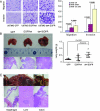Identification of an exon 4-deletion variant of epidermal growth factor receptor with increased metastasis-promoting capacity
- PMID: 21532887
- PMCID: PMC3084623
- DOI: 10.1593/neo.101744
Identification of an exon 4-deletion variant of epidermal growth factor receptor with increased metastasis-promoting capacity
Abstract
Several types of epidermal growth factor receptor (EGFR) gene alternations have been observed in human tumors. Here we present a novel EGFR variant with aberrant splicing of exon 4 (named as de4 EGFR). Variant-specific polymerase chain reaction showed that de4 EGFR was expressed in some glioma (4/40), prostate cancer (3/11), and ovarian cancer (3/9) tissues but not in tissues adjacent to tumors or normal tissues. de4 EGFR displayed an enhanced transformation and a higher metastasis-promoting capacity in comparison to wild-type EGFR. With minimal EGF-binding activity, de4 EGFR underwent ligand-independent autophosphorylation and self-dimerization. Moreover, in serum-starved condition, de4 EGFR expression in U87 MG cells significantly upregulated the extracellular signal-regulated kinase and AKT phosphorylation and expression of JUN and Src. Importantly, E-cadherin expression was barely detectable in the U87 MG cells expressing de4 EGFR and restored expression of E-cadherin in these cells inhibited their metastatic behaviors. Taken together, we identified a novel EGFR variant with increased metastasis-promoting activity that may become a promising new target for cancer therapy.
Figures







Similar articles
-
Exon 4 deletion variant of epidermal growth factor receptor enhances invasiveness and cisplatin resistance in epithelial ovarian cancer.Carcinogenesis. 2013 Nov;34(11):2639-46. doi: 10.1093/carcin/bgt216. Epub 2013 Jun 12. Carcinogenesis. 2013. PMID: 23764753
-
Growth and metastasis suppression of glioma xenografts expressing exon 4-deletion variant of epidermal growth factor receptor by monoclonal antibody CH12-mediated receptor degradation.FASEB J. 2012 Jan;26(1):73-80. doi: 10.1096/fj.11-191064. Epub 2011 Sep 14. FASEB J. 2012. PMID: 21917986
-
Prognostic effect of epidermal growth factor receptor gene mutations and the aberrant phosphorylation of Akt and ERK in ovarian cancer.Cancer Biol Ther. 2011 Jan 1;11(1):50-7. doi: 10.4161/cbt.11.1.13877. Epub 2011 Jan 1. Cancer Biol Ther. 2011. PMID: 21057220 Free PMC article.
-
Receptor "hijacking" by malignant glioma cells: a tactic for tumor progression.Cancer Lett. 2008 Aug 28;267(2):254-61. doi: 10.1016/j.canlet.2008.03.014. Epub 2008 Apr 22. Cancer Lett. 2008. PMID: 18433988 Free PMC article. Review.
-
Interplay between EGFR, E-cadherin, and PTP1B in epidermal homeostasis.Tissue Barriers. 2023 Jul 3;11(3):2104085. doi: 10.1080/21688370.2022.2104085. Epub 2022 Jul 24. Tissue Barriers. 2023. PMID: 35875939 Free PMC article. Review.
Cited by
-
The interconnectedness of cancer cell signaling.Neoplasia. 2011 Dec;13(12):1183-93. doi: 10.1593/neo.111746. Neoplasia. 2011. PMID: 22241964 Free PMC article.
-
Cancer subclonal genetic architecture as a key to personalized medicine.Neoplasia. 2013 Dec;15(12):1410-20. doi: 10.1593/neo.131972. Neoplasia. 2013. PMID: 24403863 Free PMC article.
-
Alternative Splicing: Expanding the Landscape of Cancer Biomarkers and Therapeutics.Int J Mol Sci. 2020 Nov 27;21(23):9032. doi: 10.3390/ijms21239032. Int J Mol Sci. 2020. PMID: 33261131 Free PMC article. Review.
-
Pathogenic impact of transcript isoform switching in 1,209 cancer samples covering 27 cancer types using an isoform-specific interaction network.Sci Rep. 2020 Sep 2;10(1):14453. doi: 10.1038/s41598-020-71221-5. Sci Rep. 2020. PMID: 32879328 Free PMC article.
-
The role of alternative splicing in human cancer progression.Am J Cancer Res. 2021 Oct 15;11(10):4642-4667. eCollection 2021. Am J Cancer Res. 2021. PMID: 34765285 Free PMC article. Review.
References
-
- Xue C, Wyckoff J, Liang F, Sidani M, Violini S, Tsai K, Zhang Z, Sahai E, Condeelis J, Segall JE. Epidermal growth factor receptor overexpression results in increased tumor cell motility in vivo coordinately with enhanced intravasation and metastasis. Cancer Res. 2006;66:192–197. - PubMed
-
- Pandiella A, Lehvaslaiho H, Magni M, Alitalo K, Meldolesi J. Activation of an EGFR/neu chimeric receptor: early intracellular signals and cell proliferation responses. Oncogene. 1989;4:1299–1305. - PubMed
-
- Liang K, Ang KK, Milas L, Hunter N, Fan Z. The epidermal growth factor receptor mediates radioresistance. Int J Radiat Oncol Biol Phys. 2003;57:246–254. - PubMed
-
- Ho R, Minturn JE, Hishiki T, Zhao H, Wang Q, Cnaan A, Maris J, Evans AE, Brodeur GM. Proliferation of human neuroblastomas mediated by the epidermal growth factor receptor. Cancer Res. 2005;65:9868–9875. - PubMed
-
- Modjtahedi H, Essapen S. Epidermal growth factor receptor inhibitors in cancer treatment: advances, challenges and opportunities. Anticancer Drugs. 2009;20:851–855. - PubMed
Publication types
MeSH terms
Substances
LinkOut - more resources
Full Text Sources
Other Literature Sources
Medical
Research Materials
Miscellaneous
